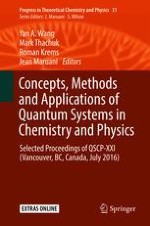2018 | Book
Concepts, Methods and Applications of Quantum Systems in Chemistry and Physics
Selected proceedings of QSCP-XXI (Vancouver, BC, Canada, July 2016)
Editors: Prof. Dr. Yan A. Wang, Prof. Dr. Mark Thachuk, Prof. Dr. Roman Krems, Prof. Dr. Jean Maruani
Publisher: Springer International Publishing
Book Series : Progress in Theoretical Chemistry and Physics
